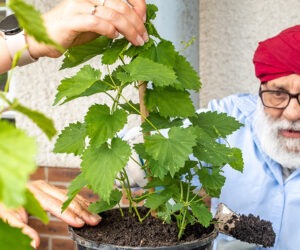High Rise Rhizome

I fell in love with the idea of Barbara the first time I laid eyes on my new cube. Is it . . .? Could it be . . .? Yes — sunlight! Following years of typing in dark corners and beneath the evil hum of fluorescent lighting, I finally had a window within arm’s reach of my desk. And — beer gods as my witness — I would put those beautiful, life-giving rays to good use.
Fortunately, it was late spring, and my three-year old Cascade vine at home in the ‘burbs was going rhizome crazy. I got up a little early for work one morning, cut myself a fine 3-inch specimen and gently wrapped the little guy (er . . . gal) in damp newspaper. Then I rummaged around our squirrel-infested garage until I came across a knotted ball of twine and an empty 12-inch pot (only slightly cracked). Crazy as I was, the thought of lugging dirt across town on my 30-minute walk from the train station seemed a bit much. So I opted to pick up some fresh potting soil on my lunch break instead.
Easier said than done. I had to hike to three different “convenience” stores and one grocery store before I struck pay dirt . . . or any dirt for that matter. Am I the only one downtown trying to grow brewing herbs in a high-rise? What’s with these city folks? The small bag of soil I found contained “Moisture Plus Crystals.” Sounds good, right? I mean, what plant wouldn’t like a little extra moisture? I’ll give you one clue: hops.
For the first couple of weeks, Barbara did great. With daily waterings, the most vigorous of her three shoots climbed about two feet up my makeshift trellis (hung from the window frame by paperclips). But then it just kind of . . . stopped. It shriveled up and died along with a second emerging shoot; I’m pretty sure their roots rotted. Without additional water, the remaining shoot actually grew a total of four feet in the opposite direction of the sun before it mysteriously became decapitated overnight. I never learned who (or what) did it, but I have my suspicions.
Undeterred, I planted a second rhizome beside the first, and this time I took it easy on the showers. Maybe a little too easy. Again, stellar growth at first, but eventually the vines became brittle and dropped leaves. All but one. The very last shoot that Barbara produced benefitted from its trail-blazing siblings. With a steady watering every three to four days it successfully grew the length of its trellis line, about eight feet, and continued to sprawl for another four. Success.
Now, the only question was, would she produce cones? My mouth was watering at the thought of making a Dilbert Dunkel, or maybe an Administrator Doppelbock. I checked each morning for a sign, but alas, it was not to be. As the summer days grew hotter, my building began to shut off the air conditioning after five. The drying effect this had on Barbara’s soil at night, combined with what was surely a crowded root system in such a small pot, soon made it impossible for me to give her enough water. She died over a long weekend, alone and coneless.
But do not cry for Barbara. For she lives on. A solid month after I cut down her crispy remains and hid her pot under my desk for the dormant season, a new shoot broke ground. Year-round hops?? At the time of this writing, there are still no cones, but Barbara is ten feet high if she’s a foot. And she’s still growing, healthier than ever.



